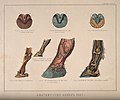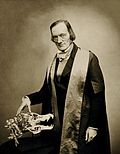Perissodactyla
Perissodactyla is an order of mammals, also known as odd-toed ungulates. This group includes three extant families: Equidae (horses), Rhinocerotidae (rhinoceroses), and Tapiridae (tapirs). The term "Perissodactyla" is derived from the Ancient Greek words "perissós" (odd) and "dáktylos" (finger/toe), referring to the uneven number of toes on the rear feet of animals in this group.
Characteristics[edit]
Members of the order Perissodactyla are characterized by an odd number of toes, with the third digit being the largest and bearing the weight of the body. They have simple stomachs and are hindgut fermenters, meaning they digest plant material in the large intestine. They also have a unique dental structure, with a gap (diastema) between the front teeth (incisors and canines) and the back teeth (molars).
Evolution[edit]
The Perissodactyla order is believed to have evolved during the late Paleocene, around 60 million years ago. The earliest known perissodactyl, Hyracotherium, was a small forest-dwelling creature. Over time, perissodactyls have evolved to adapt to various environments, from forests to grasslands.
Families[edit]
Equidae[edit]
The Equidae family includes horses, donkeys, and zebras. These animals are known for their speed and endurance, which they use to escape predators on the open plains.
Rhinocerotidae[edit]
The Rhinocerotidae family includes the five species of rhinoceros. These large, heavy animals are known for their thick skin and large horns.
Tapiridae[edit]
The Tapiridae family includes the four species of tapir. These animals are characterized by their short, prehensile snout.
Conservation[edit]
Many species within the Perissodactyla order are threatened or endangered due to habitat loss and hunting. Conservation efforts are ongoing to protect these unique animals.
See also[edit]
|
|
|
-
Perissodactyla
-
Rhinoceros male
-
Anatomy of the horse's foot
-
Tapir at Hamburg Zoo
-
Indian Rhino
-
Tapir baby
-
Paleotherium magnum
-
Chalicotherium
-
Paraceratherium scale diagram
-
Hyracotherium (Eohippus)
-
Richard Owen, 1856
-
Equus quagga quagga, coloured
Ad. Transform your life with W8MD's Budget GLP-1 injections from $75


W8MD offers a medical weight loss program to lose weight in Philadelphia. Our physician-supervised medical weight loss provides:
- Weight loss injections in NYC (generic and brand names):
- Zepbound / Mounjaro, Wegovy / Ozempic, Saxenda
- Most insurances accepted or discounted self-pay rates. We will obtain insurance prior authorizations if needed.
- Generic GLP1 weight loss injections from $75 for the starting dose.
- Also offer prescription weight loss medications including Phentermine, Qsymia, Diethylpropion, Contrave etc.
NYC weight loss doctor appointmentsNYC weight loss doctor appointments
Start your NYC weight loss journey today at our NYC medical weight loss and Philadelphia medical weight loss clinics.
- Call 718-946-5500 to lose weight in NYC or for medical weight loss in Philadelphia 215-676-2334.
- Tags:NYC medical weight loss, Philadelphia lose weight Zepbound NYC, Budget GLP1 weight loss injections, Wegovy Philadelphia, Wegovy NYC, Philadelphia medical weight loss, Brookly weight loss and Wegovy NYC
|
WikiMD's Wellness Encyclopedia |
| Let Food Be Thy Medicine Medicine Thy Food - Hippocrates |
Medical Disclaimer: WikiMD is not a substitute for professional medical advice. The information on WikiMD is provided as an information resource only, may be incorrect, outdated or misleading, and is not to be used or relied on for any diagnostic or treatment purposes. Please consult your health care provider before making any healthcare decisions or for guidance about a specific medical condition. WikiMD expressly disclaims responsibility, and shall have no liability, for any damages, loss, injury, or liability whatsoever suffered as a result of your reliance on the information contained in this site. By visiting this site you agree to the foregoing terms and conditions, which may from time to time be changed or supplemented by WikiMD. If you do not agree to the foregoing terms and conditions, you should not enter or use this site. See full disclaimer.
Credits:Most images are courtesy of Wikimedia commons, and templates, categories Wikipedia, licensed under CC BY SA or similar.
Translate this page: - East Asian
中文,
日本,
한국어,
South Asian
हिन्दी,
தமிழ்,
తెలుగు,
Urdu,
ಕನ್ನಡ,
Southeast Asian
Indonesian,
Vietnamese,
Thai,
မြန်မာဘာသာ,
বাংলা
European
español,
Deutsch,
français,
Greek,
português do Brasil,
polski,
română,
русский,
Nederlands,
norsk,
svenska,
suomi,
Italian
Middle Eastern & African
عربى,
Turkish,
Persian,
Hebrew,
Afrikaans,
isiZulu,
Kiswahili,
Other
Bulgarian,
Hungarian,
Czech,
Swedish,
മലയാളം,
मराठी,
ਪੰਜਾਬੀ,
ગુજરાતી,
Portuguese,
Ukrainian















